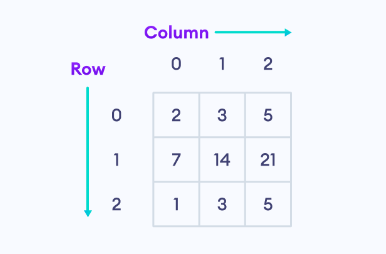矩阵是一种二维数据结构,数据排列成行和列。例如:

这里,上面的矩阵是一个 3 * 3(读作“三乘三”)矩阵,因为它有 3 行和 3 列。
在 R 中创建矩阵
在 R 中,我们使用 matrix() 函数来创建矩阵。
matrix() 函数的语法是
matrix(vector, nrow, ncol)这里,
- vector - 相同类型的数据项
nrow- 行数ncol- 列数- byrow (可选) - 如果为
TRUE,则矩阵按行填充。默认情况下,矩阵按列填充。
让我们看一个例子,
# create a 2 by 3 matrix
matrix1 <- matrix(c(1, 2, 3, 4, 5, 6), nrow = 2, ncol = 3, byrow = TRUE)
print(matrix1)输出
[,1] [,2] [,3] [1,] 1 2 3 [2,] 4 5 6
在上面的示例中,我们使用了 matrix() 函数来创建一个名为 matrix1 的矩阵。
matrix(c(1, 2, 3, 4, 5, 6), nrow = 2, ncol = 3, byrow = TRUE)在这里,我们传递了整数类型的数据项,并使用 c() 将数据项组合在一起。nrow = 2 和 ncol = 3 表示矩阵有 2 行和 3 列。
由于我们传递了 byrow = TRUE,矩阵中的数据项按行填充。如果我们没有传递 byrow 参数,如下:
matrix(c(1, 2, 3, 4, 5, 6), nrow = 2, ncol = 3)输出将是
[,1] [,2] [,3] [1,] 1 3 5 [2,] 2 4 6
在 R 中访问矩阵元素
我们使用向量索引运算符 [ ] 来访问 R 矩阵中的特定元素。
访问矩阵元素的语法是
matrix[n1, n2]这里,
n1- 指定行位置n2- 指定列位置
让我们看一个例子,
matrix1 <- matrix(c("Sabby", "Cathy", "Larry", "Harry"), nrow = 2, ncol = 2)
print(matrix1)
# access element at 1st row, 2nd column
cat("\nDesired Element:", matrix1[1, 2])输出
[,1] [,2] [1,] "Sabby" "Larry" [2,] "Cathy" "Harry" Desired Element: Larry
在上面的示例中,我们创建了一个名为 matrix1 的 2 行 2 列矩阵,包含 4 个字符串类型数据。注意索引运算符 [] 的使用,
matrix1[1, 2]这里,[1, 2] 指定我们试图访问位于 第 1 行,第 2 列的元素,即 "Larry"。
访问整行或整列
在 R 中,我们还可以根据 [] 中传递的值访问整行或整列。
[n, ]- 返回 第 n 行的所有元素。[ ,n]- 返回 第 n 列的所有元素。
例如,
matrix1 <- matrix(c("Sabby", "Cathy", "Larry", "Harry"), nrow = 2, ncol = 2)
print(matrix1)
# access entire element at 1st row
cat("\n1st Row:", matrix1[1, ])
# access entire element at 2nd column
cat("\n2nd Column:", matrix1[, 2])输出
[,1] [,2] [1,] "Sabby" "Larry" [2,] "Cathy" "Harry" 1st Row: Sabby Larry 2nd Column: Larry Harry
这里,
matrix1[1, ]- 访问 第 1 行的所有元素,即Sabby和Larrymatrix1[ ,2]- 访问 第 2 列的所有元素,即Larry和Harry
访问多行或多列
我们可以使用 c() 函数在 R 中访问多行或多列。
[c(n1,n2), ]- 返回 n1 和 n2 行的所有元素。[ ,c(n1,n2)]- 返回 n1 和 n2 列的所有元素。
例如,
# create 2 by 3 matrix
matrix1 <- matrix(c(10, 20, 30, 40, 50, 60), nrow = 2, ncol = 3)
print(matrix1)
# access entire element of 1st and 3rd row
cat("\n1st and 2nd Row:", matrix1[c(1,3), ])
# access entire element of 2nd and 3rd column
cat("\n2nd and 3rd Column:", matrix1[ ,c(2,3)])输出
[,1] [,2] [,3] [1,] 10 30 50 [2,] 20 40 60 1st and 3rd Row: 10 20 30 40 50 60 2nd and 3rd Column: 30 40 50 60
这里,
[c(1,3), ]- 返回 第 1 行和 第 3 行的所有元素。[ ,c(2,3)]- 返回 第 2 列和 第 3 列的所有元素。
在 R 中修改矩阵元素
我们使用向量索引运算符 [] 来修改指定的元素。例如:
matrix1[1,2] = 140这里,位于 第 1 行、第 2 列的元素被更改为 140。
让我们看一个例子,
# create 2 by 2 matrix
matrix1 <- matrix(c(1, 2, 3, 4), nrow = 2, ncol = 2)
# print original matrix
print(matrix1)
# change value at 1st row, 2nd column to 5
matrix1[1,2] = 5
# print updated matrix
print(matrix1)输出
[,1] [,2]
[1,] 1 3
[2,] 2 4
[,1] [,2]
[1,] 1 5
[2,] 2 4
在 R 中组合两个矩阵
在 R 中,我们使用 cbind() 和 rbind() 函数将两个矩阵组合在一起。
cbind()- 按列组合两个矩阵rbind()- 按行组合两个矩阵
我们要组合的两个矩阵的行数和列数必须相等。例如:
# create two 2 by 2 matrices
even_numbers <- matrix(c(2, 4, 6, 8), nrow = 2, ncol = 2)
odd_numbers <- matrix(c(1, 3, 5, 7), nrow = 2, ncol = 2)
# combine two matrices by column
total1 <- cbind(even_numbers, odd_numbers)
print(total1)
# combine two matrices by row
total2 <- rbind(even_numbers, odd_numbers)
print(total2)输出
[,1] [,2] [,3] [,4]
[1,] 2 6 1 5
[2,] 4 8 3 7
[,1] [,2]
[1,] 2 6
[2,] 4 8
[3,] 1 5
[4,] 3 7
这里,我们首先使用 cbind() 函数按列组合了两个矩阵:even_numbers 和 odd_numbers。然后使用 rbind() 按行组合两个矩阵。
检查 R 矩阵中是否存在元素
在 R 中,我们使用 %in% 运算符来检查指定元素是否存在于矩阵中,并返回一个布尔值。
TRUE- 如果指定元素存在于矩阵中FALSE- 如果指定元素不存在于矩阵中
例如,
matrix1 <- matrix(c("Sabby", "Cathy", "Larry", "Harry"), nrow = 2, ncol = 2)
"Larry" %in% matrix1 # TRUE
"Kinsley" %in% matrix1 # FALSE输出
TRUE FALSE
这里,
"Larry"存在于 matrix1 中,因此该方法返回TRUE"Kinsley"不存在于 matrix1 中,因此该方法返回FALSE